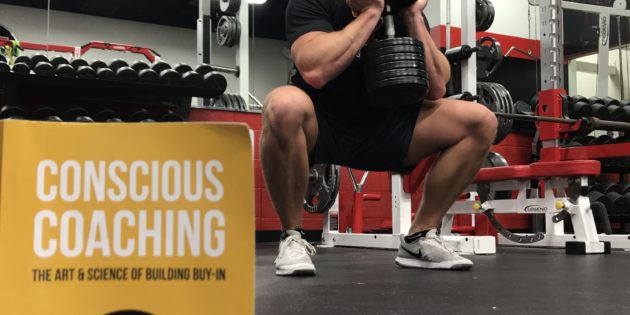Here are my 10 key points from Brett Bartholomew’s book “Conscious Coaching: The Art & Science of Building Buy-In”
1) Buy-in is trust – a combination of loyalty, results, and consistent positive actions.
2) Relay information in a personal manner – this makes it more powerful. “Don’t just teach the lessons, tell the stories.”
3) Be patient about developing buy-in. “Athletes can be led, guided, and even loved, but may not be ready for change or to award trust at the same time that you are.”
4) “If you have identified your training philosophy before you have identified your coaching identity then you have misplaced your priorities.”
 5) “When you get into a fistfight, it’s not the guy that is bigger, taller, stronger, or more powerful that you should fear; but rather the guy that isn’t fazed by the sight or taste of his own blood.”
5) “When you get into a fistfight, it’s not the guy that is bigger, taller, stronger, or more powerful that you should fear; but rather the guy that isn’t fazed by the sight or taste of his own blood.”
6) Know who you are. “Becoming a better communicator first and foremost requires tremendous self-reflection.”
7) Be who you are. “It is authenticity, not mimicry, that best serves as the coach’s initial linchpin toward establishing a strong connection with others.”
8) “People who need to know the right “why” are typically the folks who were frustrated by math growing up as we were often told as kids that certain rules exist simply because “that’s the way it is.””
9) Adapt yourself to the world, not the world to yourself. “The reality is that YOU must treat people the way that THEY want to be treated.”
10) People want a wide range of emotions from their leader. “When coaching athletes, too much emotional stability can come across as emotional staleness, as it is the periodic expression of real emotions that serve as a psychological performance enhancer as it pertains to enhancing a leader’s credibility with those he/she hopes to influence (Kouzes & Posner, 2003).”
- “In some instances, researchers have even found that some of the most influential and successful leaders of all-time rank high in the trait of psychopathy, which is the opposite of emotional stability!”
- The “Teddy Effect” references Theodore Roosevelt and how he wasn’t scared to share his true personality and was able to leverage a wide range of traits and emotions while leading others.
- “One narrative throughout history that will never change is that the most effective leaders are able to shift between both bright-sided and dark-sided emotional states.” – being who we really are.
To learn more about Brett’s art and science of building buy-in, how to approach the 16 athlete archetypes, and methods to deal with coach-athlete relational roadblocks, purchase the book here.


Jake introduced his Hypertrophy Cluster Training to me while I was at Judson University coaching. We were looking for a program to start our players on to start our spring strength training. Myself and the rest of the coaching staff didn’t have enough knowledge on how to help our guys get to the next level. The first three weeks of our strength training you could see that they were getting stronger and gaining mass. The program was laid out in a format that was easy for our guys to understand so we could get maximal results. I thought our strength program definitely took a big step while using this program.
Cole Schreiner - Northland College Assistant Men's Basketball Coach
PURCHASE HYPERTROPHY CLUSTER PROTOCOL HERE



